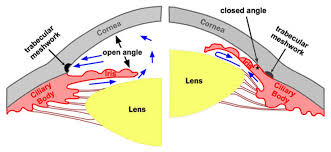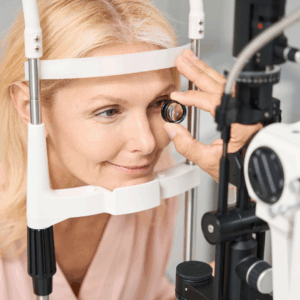Understanding Open and Closed Angle Glaucoma
Posted in Eye Blog, Mount Vernon, Sedro-Woolley, Stanwood, Whidbey
You probably have heard of open angle and angle closure glaucoma. But what is the difference?

First of all, we need to know what glaucoma is. Glaucoma is a group of diseases that causes damage to the optic nerve, resulting in peripheral vision loss and eventually leading to permanent blindness if not treated appropriately. It is often caused by increased intraocular pressure (pressure inside your eye).
Open Angle Glaucoma
Open angle glaucoma is called “open” because it has a wide and open angle between the iris and the cornea. The “angle” is where eye fluid drainage known as the “trabecular meshwork” is located. In this type of glaucoma, the trabecular meshwork is visible by your eye doctor using a special instrument. Glaucoma formed by this type is often caused by an internal clog, causing the intraocular pressure to be elevated. The increase in eye pressure is usually gradual. This type of glaucoma is the most common type.
Risk factors for open angle glaucoma include people with elevated intraocular pressure, a family history of glaucoma and patients aged 60 years and older. African Americans aged 40 and older are also at risk. People of Korean and Japanese descent as well as individuals with cardiovascular and autoimmune disease are at risk for what we call low tension glaucoma or open angle glaucoma with no history of elevated eye pressures. Other risk factors include being severely nearsighted, diabetes, previous eye surgery or trauma, elevated blood pressure and use of corticosteroids.
Closed Angle Glaucoma
In closed angle glaucoma, the angle between the iris and the cornea is narrow or closed, and the trabecular meshwork is barely visible or not at all. This type of glaucoma can cause a sudden increase in intraocular pressure and often requires immediate medical treatment.

Risk factors for this type of glaucoma include people aged 40 years and over, a family history of glaucoma, poor short-distance vision or farsightedness, previous eye surgery or trauma, East Asian or Inuit ethnicity, and patients with narrow angles. Using medications for allergy, anxiety, depression, overactive bladder and migraines may be ill-advised if you are at risk for this type of glaucoma.
Glaucoma Treatment
Your eye doctor distinguishes the two types of glaucoma by using a special lens called a “gonioscopy”. This is a mirror that indirectly views the angles in the slit lamp. Others use an ocular imaging of the eye’s anterior chamber known as the optical coherence tomography or OCT.
Why is it important to make a distinction? Although the treatment goal to lower the intraocular pressure is the same, the approach may be slightly different. Since increased intraocular pressure is more abrupt in closed angle glaucoma, a more aggressive treatment is indicated. A laser iridotomy is the treatment of choice for this kind of glaucoma wherein a hole is made in the outermost side of the iris to open up the angle. For open angle glaucoma, since elevated intraocular pressure is more gradual, eye drops are usually the first choice. A laser called “selective laser trabeculoplasty” can also be used as an alternative to eye drops. This laser targets the trabecular meshwork to remove clogs inside the drain and enhance more outflow of the eye’s fluids.
Are you at risk of getting one of these types of glaucoma? It may be time to make an appointment with your eye doctor!
Contact Cascadia Eye
If you would like to learn more, or if you would like to schedule an appointment or consultation with our talented doctors at Cascadia Eye, please contact us today. Our entire team is committed to protecting and improving your vision and the health of your eyes. We are happy to answer any questions you might have!
In addition, join us on Facebook, Instagram or YouTube to ask your questions about eyes, exams, and our practice. We’d love to hear from you – and there might be a blog to address your questions in the future.



